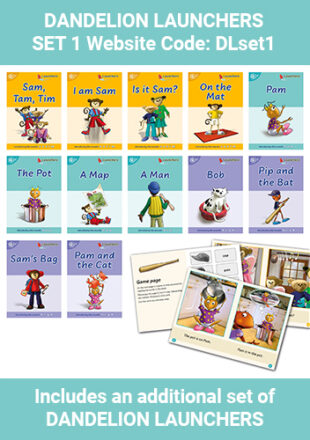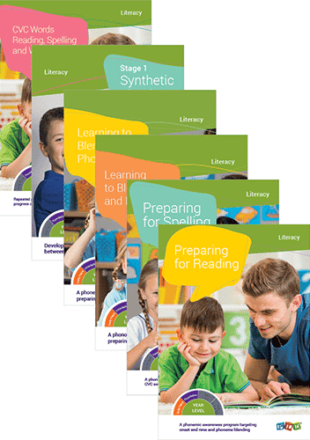Age
Showing 145–160 of 459 results
-
PLD Decodable Reading Books (Set 7 – ar or er ay ai oy oi al ng)
PLD’s new range of Decodable Reading books will fit seamlessly into your teaching allowing children to use their new knowledge of phonics to decode these delightful stories. Structured with between 15-30 books at each level, children can complete a level with a variety of books available to keep their reading fun and interesting. The step-by-step […]
PLD’s new range of Decodable Reading books will fit seamlessly into your teaching allowing children to use their new knowledge of phonics to decode these
$250.00[flipbook-popup id=''][/flipbook-popup] -
PLD Decodable Reading Books (Set 3 – CVC g o u l f b)
PLD’s new range of Decodable Reading books will fit seamlessly into your teaching allowing children to use their new knowledge of phonics to decode these delightful stories. Structured with between 15-30 books at each level, children can complete a level with a variety of books available to keep their reading fun and interesting. The step-by-step […]
PLD’s new range of Decodable Reading books will fit seamlessly into your teaching allowing children to use their new knowledge of phonics to decode these
$200.00[flipbook-popup id=''][/flipbook-popup] -
PLD Decodable Reading Books (Set 5 – ck sh ch th oo ee qu wh x)
PLD’s new range of Decodable Reading books will fit seamlessly into your teaching allowing children to use their new knowledge of phonics to decode these delightful stories. Structured with between 15-30 books at each level, children can complete a level with a variety of books available to keep their reading fun and interesting. The step-by-step […]
PLD’s new range of Decodable Reading books will fit seamlessly into your teaching allowing children to use their new knowledge of phonics to decode these
$250.00[flipbook-popup id=''][/flipbook-popup] -
PLD Decodable Reading Books (Set 4 – CVC w j v k z y)
PLD’s new range of Decodable Reading books will fit seamlessly into your teaching allowing children to use their new knowledge of phonics to decode these delightful stories. Structured with between 15-30 books at each level, children can complete a level with a variety of books available to keep their reading fun and interesting. The step-by-step […]
PLD’s new range of Decodable Reading books will fit seamlessly into your teaching allowing children to use their new knowledge of phonics to decode these
$200.00[flipbook-popup id=''][/flipbook-popup] -
Dandelion Launchers – (Set 1) VC & CVC – Foundation Semester 1
28 Decodable VC & CVC Home Reading Books with minimal high frequency words.
The 28 modern and engaging decodable reading books in this curated set align with the PLD’s evidence-based Structured Synthetic Phonics program. These take-home reading books
$170.00[flipbook-popup id=''][/flipbook-popup] -
PLD Decodable Reading Books (Set 6 – CCVC & CVCC)
PLD’s new range of Decodable Reading books will fit seamlessly into your teaching allowing children to use their new knowledge of phonics to decode these delightful stories. Structured with between 15-30 books at each level, children can complete a level with a variety of books available to keep their reading fun and interesting. The step-by-step […]
PLD’s new range of Decodable Reading books will fit seamlessly into your teaching allowing children to use their new knowledge of phonics to decode these
$250.00[flipbook-popup id=''][/flipbook-popup] -
Integrated SSP Kit for Year 3
Please note: The components in the Integrated SSP Kit cannot be separated. It is available for sale as one integrated kit only. It is a single-classroom kit and is not designed for sharing across classrooms. PLD’s Integrated SSP Kit for Year 3 streamlines the teaching experience within the framework of PLD’s Structured Synthetic Phonics (SSP) […]
Please note: The components in the Integrated SSP Kit cannot be separated. It is available for sale as one integrated kit only. It is a
$825.00[flipbook-popup id=''][/flipbook-popup] -
Integrated SSP Kit for Year 4
Please note: The components in the Integrated SSP Kit cannot be separated. It is available for sale as one integrated kit only. It is a single-classroom kit and is not designed for sharing across classrooms. PLD’s Integrated SSP Kit for Year 4 streamlines the teaching experience within the framework of PLD’s Structured Synthetic Phonics (SSP) […]
Please note: The components in the Integrated SSP Kit cannot be separated. It is available for sale as one integrated kit only. It is a
$825.00[flipbook-popup id=''][/flipbook-popup] -
Integrated SSP Support Kit
Available for PRE-ORDER with delivery for the 2026 school year. The SSP Support Kit delivers Tier 3 instruction across three levels of targeted support. An individually administered program, delivered at least three times per week for approximately 20 minutes (extendable to 30-45 mins as required) A classroom component, enabling students receiving individualised support to remain […]
Available for PRE-ORDER with delivery for the 2026 school year. The SSP Support Kit delivers Tier 3 instruction across three levels of targeted support. An
$975.00[flipbook-popup id=''][/flipbook-popup] -
Integrated SSP Kit for Year 2
Please note: The components in the Integrated SSP Kit cannot be separated. It is available for sale as one integrated kit only. It is a single-classroom kit and is not designed for sharing across classrooms. PLD’s Integrated SSP Kit for Year 2 streamlines the teaching experience within the framework of PLD’s Structured Synthetic Phonics […]
Please note: The components in the Integrated SSP Kit cannot be separated. It is available for sale as one integrated kit only. It is
$825.00[flipbook-popup id=''][/flipbook-popup] -
Integrated SSP Kit for Year 5
Available for Pre-ORDER now with delivery end of Term 3 2025 Please note: The components in the Integrated SSP Kit cannot be separated. It is available for sale as one integrated kit only. It is a single-classroom kit and is not designed for sharing across classrooms. PLD’s Integrated SSP Kit for Year 5 streamlines […]
Available for Pre-ORDER now with delivery end of Term 3 2025 Please note: The components in the Integrated SSP Kit cannot be separated. It
$825.00[flipbook-popup id=''][/flipbook-popup] -
Integrated SSP Kit for Year 6
Available for Pre-ORDER now with delivery end of Term 4 2025 Please note: The components in the Integrated SSP Kit cannot be separated. It is available for sale as one integrated kit only. It is a single-classroom kit and is not designed for sharing across classrooms. PLD’s Integrated SSP Kit for Year 6 streamlines […]
Available for Pre-ORDER now with delivery end of Term 4 2025 Please note: The components in the Integrated SSP Kit cannot be separated. It
$825.00[flipbook-popup id=''][/flipbook-popup] -
Integrated SSP Kit for Year 1
[flipbook-popup id=''][/flipbook-popup] -
Integrated SSP Kit for Foundation
[flipbook-popup id=''][/flipbook-popup] -
Middle & Upper Primary Catch-Up Reading Books: Moon Dogs Extras
24 Decodable Reading Books for Students Requiring Stages 1 – Target 1, 2 & 3, Stage 2 – double consonants and CVC.
This set of 24 books is aligned with PLD’s Stage 1, Targets 1 (CVC). It is a contemporary series following the adventures of a group
$125.00[flipbook-popup id=''][/flipbook-popup] -
Sale!
Intensive Pre-Literacy Skills Teaching Pack
Supporting students entering Year 1 and 2 with low literacy skills.
Buy all six resources in a bundle and save 15%. Click on each of the links below if you wish to view the stages individually.
From $401.64


















